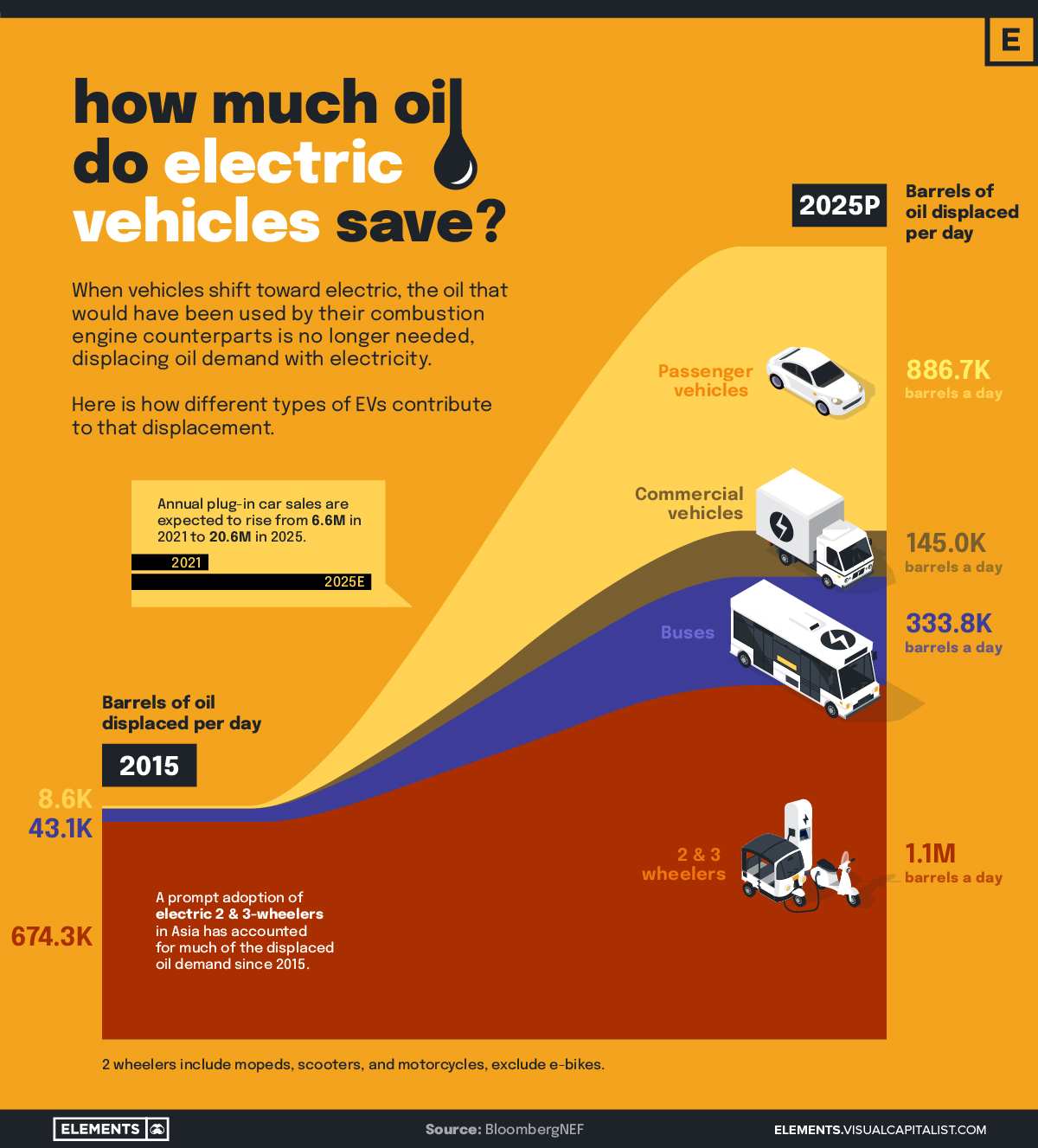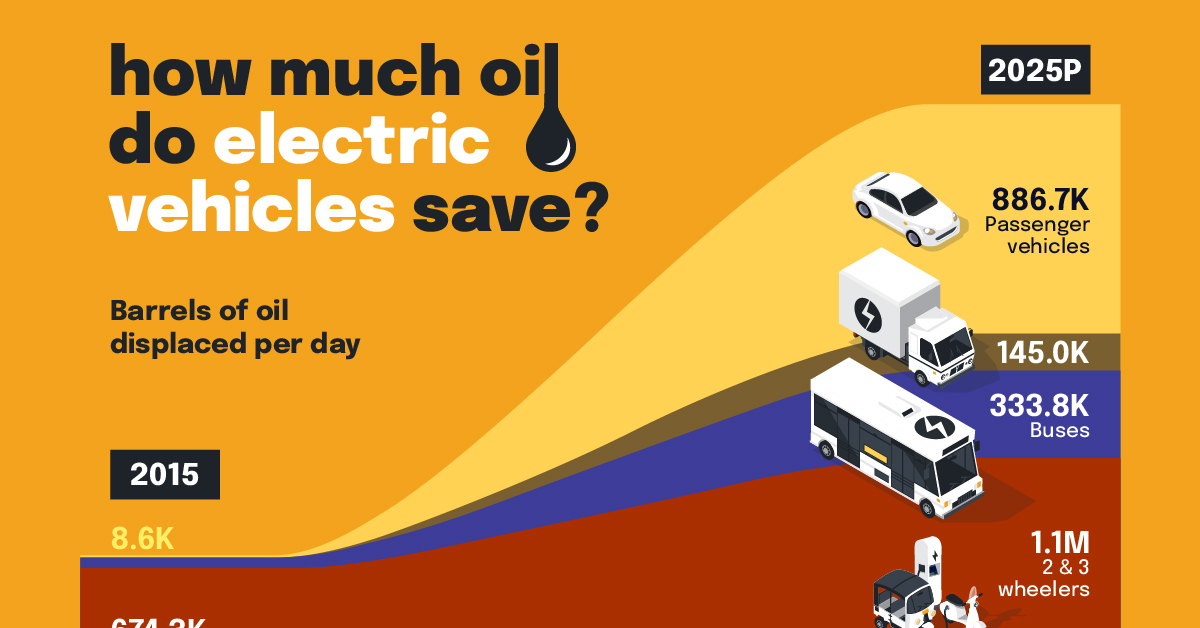Energy
How EV Adoption Will Impact Oil Consumption (2015-2025P)
![]() Subscribe to the Elements free mailing list for more like this
Subscribe to the Elements free mailing list for more like this

The EV Impact on Oil Consumption
This was originally posted on Elements. Sign up to the free mailing list to get beautiful visualizations on real assets and resource megatrends each week.
As the world moves towards the electrification of the transportation sector, demand for oil will be replaced by demand for electricity.
To highlight the EV impact on oil consumption, the above infographic shows how much oil has been and will be saved every day between 2015 and 2025 by various types of electric vehicles, according to BloombergNEF.
How Much Oil Do Electric Vehicles Save?
A standard combustion engine passenger vehicle in the U.S. uses about 10 barrels of oil equivalent (BOE) per year. A motorcycle uses 1, a Class 8 truck about 244, and a bus uses more than 276 BOEs per year.
When these vehicles become electrified, the oil their combustion engine counterparts would have used is no longer needed, displacing oil demand with electricity.
Since 2015, two and three-wheeled vehicles, such as mopeds, scooters, and motorcycles, have accounted for most of the oil saved from EVs on a global scale. With a wide adoption in Asia specifically, these vehicles displaced the demand for almost 675,000 barrels of oil per day in 2015. By 2021, this number had quickly grown to 1 million barrels per day.
Let’s take a look at the daily displacement of oil demand by EV segment.
| Number of barrels saved per day, 2015 | Number of barrels saved per day, 2025P | |
|---|---|---|
| Electric Passenger Vehicles | 8,600 | 886,700 |
| Electric Commercial Vehicles | 0 | 145,000 |
| Electric Buses | 43,100 | 333,800 |
| Electric Two & Three-Wheelers | 674,300 | 1,100,000 |
| Total Oil Barrels Per Day | 726,000 | 2,465,500 |
Today, while work is being done in the commercial vehicle segment, very few large trucks on the road are electric—however, this is expected to change by 2025.
Meanwile, electric passenger vehicles have shown the biggest growth in adoption since 2015.
In 2022, the electric car market experienced exponential growth, with sales exceeding 10 million cars. The market is expected to continue its strong growth throughout 2023 and beyond, eventually coming to save a predicted 886,700 barrels of oil per day in 2025.
From Gas to Electric
While the world shifts from fossil fuels to electricity, BloombergNEF predicts that the decline in oil demand does not necessarily equate to a drop in oil prices.
In the event that investments in new supply capacity decrease more rapidly than demand, oil prices could still remain unstable and high.
The shift toward electrification, however, will likely have other implications.
While most of us associate electric vehicles with lower emissions, it’s good to consider that they are only as sustainable as the electricity used to charge them. The shift toward electrification, then, presents an incredible opportunity to meet the growing demand for electricity with clean energy sources, such as wind, solar and nuclear power.
The shift away from fossil fuels in road transport will also require expanded infrastructure. EV charging stations, expanded transmission capacity, and battery storage will likely all be key to supporting the wide-scale transition from gas to electricity.
Energy
Charted: 4 Reasons Why Lithium Could Be the Next Gold Rush
Visual Capitalist has partnered with EnergyX to show why drops in prices and growing demand may make now the right time to invest in lithium.

4 Reasons Why You Should Invest in Lithium
Lithium’s importance in powering EVs makes it a linchpin of the clean energy transition and one of the world’s most precious minerals.
In this graphic, Visual Capitalist partnered with EnergyX to explore why now may be the time to invest in lithium.
1. Lithium Prices Have Dropped
One of the most critical aspects of evaluating an investment is ensuring that the asset’s value is higher than its price would indicate. Lithium is integral to powering EVs, and, prices have fallen fast over the last year:
| Date | LiOH·H₂O* | Li₂CO₃** |
|---|---|---|
| Feb 2023 | $76 | $71 |
| March 2023 | $71 | $61 |
| Apr 2023 | $43 | $33 |
| May 2023 | $43 | $33 |
| June 2023 | $47 | $45 |
| July 2023 | $44 | $40 |
| Aug 2023 | $35 | $35 |
| Sept 2023 | $28 | $27 |
| Oct 2023 | $24 | $23 |
| Nov 2023 | $21 | $21 |
| Dec 2023 | $17 | $16 |
| Jan 2024 | $14 | $15 |
| Feb 2024 | $13 | $14 |
Note: Monthly spot prices were taken as close to the 14th of each month as possible.
*Lithium hydroxide monohydrate MB-LI-0033
**Lithium carbonate MB-LI-0029
2. Lithium-Ion Battery Prices Are Also Falling
The drop in lithium prices is just one reason to invest in the metal. Increasing economies of scale, coupled with low commodity prices, have caused the cost of lithium-ion batteries to drop significantly as well.
In fact, BNEF reports that between 2013 and 2023, the price of a Li-ion battery dropped by 82%.
| Year | Price per KWh |
|---|---|
| 2023 | $139 |
| 2022 | $161 |
| 2021 | $150 |
| 2020 | $160 |
| 2019 | $183 |
| 2018 | $211 |
| 2017 | $258 |
| 2016 | $345 |
| 2015 | $448 |
| 2014 | $692 |
| 2013 | $780 |

3. EV Adoption is Sustainable
One of the best reasons to invest in lithium is that EVs, one of the main drivers behind the demand for lithium, have reached a price point similar to that of traditional vehicle.
According to the Kelly Blue Book, Tesla’s average transaction price dropped by 25% between 2022 and 2023, bringing it in line with many other major manufacturers and showing that EVs are a realistic transport option from a consumer price perspective.
| Manufacturer | September 2022 | September 2023 |
|---|---|---|
| BMW | $69,000 | $72,000 |
| Ford | $54,000 | $56,000 |
| Volkswagon | $54,000 | $56,000 |
| General Motors | $52,000 | $53,000 |
| Tesla | $68,000 | $51,000 |
4. Electricity Demand in Transport is Growing
As EVs become an accessible transport option, there’s an investment opportunity in lithium. But possibly the best reason to invest in lithium is that the IEA reports global demand for the electricity in transport could grow dramatically by 2030:
| Transport Type | 2022 | 2025 | 2030 |
|---|---|---|---|
| Buses 🚌 | 23,000 GWh | 50,000 GWh | 130,000 GWh |
| Cars 🚙 | 65,000 GWh | 200,000 GWh | 570,000 GWh |
| Trucks 🛻 | 4,000 GWh | 15,000 GWh | 94,000 GWh |
| Vans 🚐 | 6,000 GWh | 16,000 GWh | 72,000 GWh |
The Lithium Investment Opportunity
Lithium presents a potentially classic investment opportunity. Lithium and battery prices have dropped significantly, and recently, EVs have reached a price point similar to other vehicles. By 2030, the demand for clean energy, especially in transport, will grow dramatically.
With prices dropping and demand skyrocketing, now is the time to invest in lithium.
EnergyX is poised to exploit lithium demand with cutting-edge lithium extraction technology capable of extracting 300% more lithium than current processes.

-

 Lithium5 days ago
Lithium5 days agoRanked: The Top 10 EV Battery Manufacturers in 2023
Asia dominates this ranking of the world’s largest EV battery manufacturers in 2023.
-

 Energy1 week ago
Energy1 week agoThe World’s Biggest Nuclear Energy Producers
China has grown its nuclear capacity over the last decade, now ranking second on the list of top nuclear energy producers.
-

 Energy1 month ago
Energy1 month agoThe World’s Biggest Oil Producers in 2023
Just three countries accounted for 40% of global oil production last year.
-

 Energy1 month ago
Energy1 month agoHow Much Does the U.S. Depend on Russian Uranium?
Currently, Russia is the largest foreign supplier of nuclear power fuel to the U.S.
-

 Uranium2 months ago
Uranium2 months agoCharted: Global Uranium Reserves, by Country
We visualize the distribution of the world’s uranium reserves by country, with 3 countries accounting for more than half of total reserves.
-

 Energy3 months ago
Energy3 months agoVisualizing the Rise of the U.S. as Top Crude Oil Producer
Over the last decade, the United States has established itself as the world’s top producer of crude oil, surpassing Saudi Arabia and Russia.
-

 Science7 days ago
Science7 days agoVisualizing the Average Lifespans of Mammals
-

 Markets2 weeks ago
Markets2 weeks agoThe Top 10 States by Real GDP Growth in 2023
-

 Demographics2 weeks ago
Demographics2 weeks agoThe Smallest Gender Wage Gaps in OECD Countries
-

 United States2 weeks ago
United States2 weeks agoWhere U.S. Inflation Hit the Hardest in March 2024
-

 Green2 weeks ago
Green2 weeks agoTop Countries By Forest Growth Since 2001
-

 United States2 weeks ago
United States2 weeks agoRanked: The Largest U.S. Corporations by Number of Employees
-

 Maps2 weeks ago
Maps2 weeks agoThe Largest Earthquakes in the New York Area (1970-2024)
-

 Green2 weeks ago
Green2 weeks agoRanked: The Countries With the Most Air Pollution in 2023













